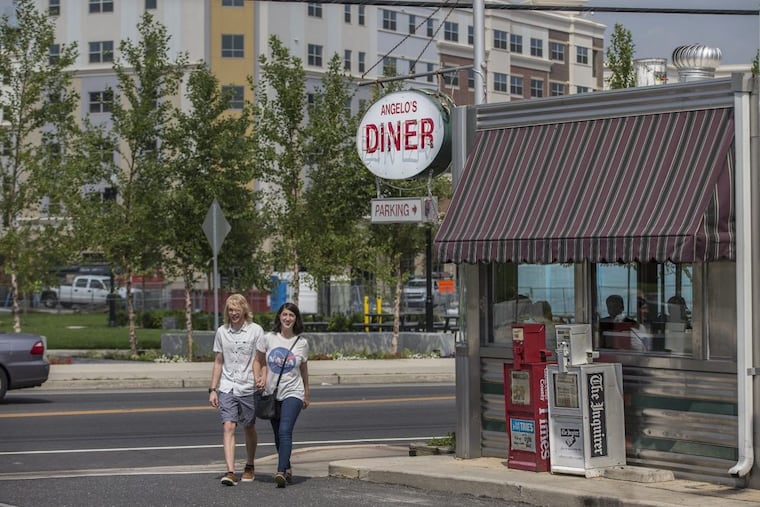In Glassboro, Rowan's boulevard of dreams may be coming true
Set for completion in 2018, the $350 million Rowan Boulevard project may knit town and gown together.

Angelo's Diner hasn't changed much since it was built in 1951. "We still don't take credit cards," Mary Ann Justice, the owner, says.
But through the classic diner's windows along North Main Street in Glassboro, the view is dramatically different from decades past: A stylish park where a nuisance bar and an abandoned gas station once stood is flanked by the sleek mid-rise, mixed-use buildings of the Rowan Boulevard project.
The $350 million effort aims to create, from scratch, a new downtown with a boulevard that bridges the gap between the growing Rowan University campus along Route 322 and the borough's vintage commercial center at Main and High Streets. The idea is to bolster town and gown together.
When completed in 2018, the ambitious redevelopment project will include one million square feet of commercial, institutional, and residential space, including apartment suites for nearly 4,200 students. A grand opening for the three latest buildings is set for Wednesday, Aug. 23.
"It's one of the most important steps toward making Glassboro a true college town," says Mayor Leo McCabe.
Anyone familiar with the faded array of commercial and residential buildings that formerly occupied the 26-acre site will likely be impressed by the transformation that began in 2009. The boulevard and the spruced-up area around Main and High reflect the expansion and evolution of the formerly rural campus over the last 25 years.
"Glassboro went from being a sleepy town to a much livelier town," says Jim Nagle, an Angelo's regular.
But Christine Maxwell and some other business owners along East and West High Streets are concerned that brand-name restaurants and a higher-end ambience will make Rowan Boulevard an island unto itself, with little impact on the working-class downtown.
"I'd like to see more traffic from the college kids," says Maxwell, whose Ms. Chrissy's Sweet Cafe opened on East High three years ago.
"There's a shuttle bus from the college, but it stops at the corner of Main and doesn't come down this part of High Street," she adds.
"Business along here was better in the '90s," says Marvin Johnson, the proprietor of Marvin's Haircuts, a fixture on East High for 26 years.
Says Mark Lovallo, who owns a West High restaurant called Little Beef's: "The proof is not in the pudding yet."
The goal of the project, a partnership among the borough, the university, and the real estate firm Nexus Properties, "is to make the town, not just Rowan Boulevard, a destination," says Ronda Abbruzzese, vice president of marketing at Nexus.
The contrast between old and new is dramatic: the handsome boulevard with its urban, if not quite urbane, feel, and small-town High and Main Streets, with their low-slung buildings, traditional businesses, and empty spaces. The task of making them into a single cohesive place remains very much a work in progress.
"It looks nice, but there are a lot of empty storefronts," says Ian McKane, 21, a senior civil and environmental engineering student from Gloucester Township. He paused to chat while moving into one of the student apartment suites.
Around downtown, some of the decorative directional signs seem rather aspirational: Some point the way to a "Theater district" that includes an empty lot where the long-vacant Roxy movie theater was torn down in 2013.
"High Street is critical," Rowan president Ali A. Houshmand says. "There are lots of plans for an arts and culture district, for major investment, along High Street."
The Rowan University Art Gallery opened at the corner of West High and Mick Drive about two years ago, and the university hopes to develop a mixed-use building to house its radio, television, and film department — and possibly a movie theater — along the street, says Houshmand.
Much as early plans for the boulevard inspired skepticism ("We've since changed the perception," Abbruzzese insists), some of the stakeholders along High Street have questions about the future.
Diana L. Pierce, a fifth-generation Glassboro resident and a trustee of the Heritage Glass Museum, a landmark on East High, says some supporters of the institution "are concerned about preserving it, which is reasonable because other structures deemed historic don't exist anymore" in the borough.
And while ACE Screen Printing & Embroidery owner Adam Szyfman is heartened by an improvement in public safety ("Like night and day") and an increase in "college-related" pedestrian traffic outside his West High business, he worries about parking and traffic.
While far from complete, or perfect, the project strikes me as skillful and savvy about what it takes to make a place where people want to be.
And a group of collaborators capable of pulling off something of this magnitude surely can find a way to, say, make sure the student shuttle bus serves the entire heart of Glassboro — and that all businesses have a chance to benefit from the expanded potential customer base the boulevard provides.
"I like the park," says Justice, standing behind the counter at Angelo's with her husband, Jim, and looking out at Rowan Boulevard. "I like what they're doing."
So do I.